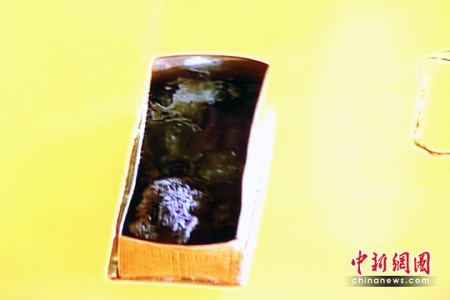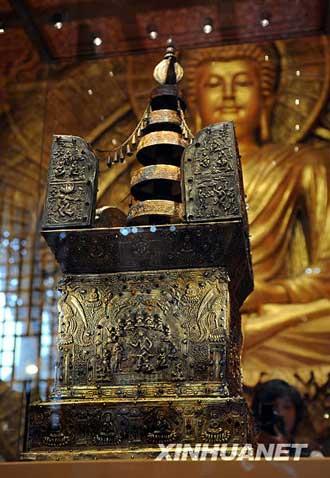புத்தர் மண்டை ஓடு கண்டுபிடிக்கப்பட்டது
புத்தர் மண்டை ஓடு கண்டுபிடிக்கப்பட்டது: சீனாவின் கிழக்கு பகுதியில் நஞ்சிங் மாகாணம் உள்ளது. இங்கு குய்ஸியா என்ற இடத்தில் பழமை வாய்ந்த புத்தர் கோவில் உள்ளது. இந்த கோவில் தொல் பொருள் துறையினரிடம் ஒப்படைக்கப்பட்டது. இதை தொடர்ந்து அக்கோவில் சீரமைக்கப்பட்டது. அப்போது அங்கு புதைத்து வைக்கப்பட்டிருந்த ஒரு மண்டை ஓட்டின் ஒரு பகுதி கண்டெடுக்கப்பட்டது. அது புத்தமதத்தை நிறுவிய கவுதம புத்தரின் மண்டை ஓடு என தெரிய வந்தது.
சீனாவின் பௌத்தப் பிரச்சாரம்: சீனாவைப் பொறுத்த வரைக்கும், பௌத்தத்தை அடக்கியாள நினைக்கிறது. திபெத்தை ஆக்கிரமித்து, அதனை கட்டுக்குள் வைத்திருக்க ராணுவத்தை உபயோகித்து வருகிறது. பௌத்தத்தை வைத்துக் கொண்டு, இந்தியாவிலும் நுழைந்து வேவு பார்க்கிறது. இந்த நிலையில் தாம் பௌத்தத்தை வைத்துக் கொண்டு வியாபாரம் செய்யும் முறையில், அந்த மண்டை ஓட்டுக்கு நேற்று சிறப்பு பூஜை நடத்தப்பட்டது. இந்த நிகழ்ச்சி சீனாவில் உள்ள அனைத்து டெலிவிஷன்கள் மற்றும் இண்டர்நெட்களில் நேரடியாக ஒளிபரப்பப்பட்டது.
காலநிலையில் முரண்பாடு, குளறுபடிகள் அது பொய் என்று நிரூபிக்கிறது: இந்த நிகழ்ச்சியை லட்சக்கணக்கான மக்கள் கண்டு மகிழ்ந்தனர். புத்தர் மண்டை ஓட்டின் ஒரு பகுதி இந்தியாவில் இருந்து அசோக மன்னரால் உலக நாடுகள் முழுவதும் அனுப்பப்பட்டது. அதில், ஒரு பகுதி சீனாவுக்கும் வந்தது. 25,000 ஆண்டுகள் பழமை வாய்ந்ததாக இருக்கலாம் என சீன தொல் பொருள் ஆராய்ச்சியாளர்கள் தெரிவித்துள்ளனர். 1,000 ஆண்டுகளாக இது மண்ணில் புதைக்கப்பட்டிருந்ததாகவும் கூறியுள்ளனர். மேலும், இந்த மண்டை ஓட்டை கடந்த ஆண்டு ஆகஸ்டு 2009 மாதம் கண்டுபிடித்ததாகவும், 10 மாத ஆய்வுக்கு பிறகு தான் இது புத்தரின் மண்டை ஓடு என உறுதி செய்ததாகவும் தெரிவித்தனர்.
பௌத்தமும், மேனாட்டு ஆராய்ச்சியாளர்களும்: பௌத்தத்திலிருந்து (குறிப்பாக இந்தியாவிலிருந்து) கிருத்துவம் தோன்றியது என வலுவான கருத்துகள் இருந்து வருகின்றன. ஆகையால், பௌத்தத்தின் காலத்தைக் குறைக்க அவர்கள் பல வழிகளில் சரித்திர ஆதாரங்களை மாற்றினர், மறைத்தனர், போலிகளை உருவாக்கி குழப்பினர். இன்று கூட புத்தரின் தேதி / கால நிலை உறுதியாக நிலைநிறுத்தப்படவில்லை. மாறாக, அந்த தேதியை கிரேக்கத் தத்துவ ஆரம்பங்களுக்குப் பிறகு வைக்க இன்றளவும், ஆதிக்க சக்திகளின் போலியான ஆராய்ச்சிகள் நடந்து வருகின்றன. இங்கு புத்தரின் மண்டையோட்டின் ஒரு பகுதி எப்படி பலவிதமாக தேதியிடப்படுகின்றது என்று நோக்கத்தக்கது:
- 25,000 ஆண்டுகள் பழமை வாய்ந்ததாக இருக்கலாம்: புத்தர் மண்டை ஓட்டின் ஒரு பகுதி இந்தியாவில் இருந்து அசோக மன்னரால் உலக நாடுகள் முழுவதும் அனுப்பப்பட்டது. அதில், ஒரு பகுதி சீனாவுக்கும் வந்தது. 25,000 ஆண்டுகள் பழமை வாய்ந்ததாக இருக்கலாம் என சீன தொல் பொருள் ஆராய்ச்சியாளர்கள் தெரிவித்துள்ளனர்.
- 2,500 ஆண்டுகள் பழமை வாய்ந்ததாக இருக்கலாம்.
- 1000 ஆண்டுகள் பழமை வாய்ந்ததாக இருக்கலாம்
குறிச்சொற்கள்: 25000 ஆண்டுகள் பழமை, காலநிலையில் முரண்பாடு, சீனாவின் பௌத்தப் பிரச்சாரம், புத்தர் மண்டை ஓடு




8:31 முப இல் ஜூன் 13, 2010 |
Buddha relics enshrined at Chinese temple
http://beta.thehindu.com/news/international/article454096.ece
Relics believed to be part of the skull of Gautama Buddha, the founder of Buddhism, found three years ago, were enshrined on Saturday at the Qixia Temple in Jiangsu province in China.
The relics were sent to the country from India by Emperor Ashoka and buried beneath a Chinese temple over 1,000 years ago.
The casket, in which the relics known as sarirars (parts of the body of Buddha) were preserved in two different boxes, was opened amid chanting by the monks.
The casket, containing a small-size stupa of Emperor Ashoka in which the relics were preserved, is the largest and finest ever found in China.
“Its complicated techniques are rarely seen as it was made 1,000 years ago” and it was discovered during excavations of the temple three years ago, according to one Buddhist scholar.
The casket made of gold, silver and sandalwood was found among scattered objects in an underground chamber. The relics were kept carefully in a small box made of gold, which also contained a bottle of perfume.
According to Buddhist scriptures, Emperor Ashoka collected all of Buddha’s’s sarira and stored them in pagoda-shaped shrines, before sending them to different parts of the world.
China is believed to have received 19 of them. Search is on for the rest. These caskets were not opened fearing bad luck.
8:33 முப இல் ஜூன் 13, 2010 |
Will the miniature stupa reveal Buddha relics?
English.news.cn 2010-06-13 09:37:01
http://news.xinhuanet.com/english2010/culture/2010-06/13/c_13348128.htm
The miniature stupa is 1.8 meters in height, embedded with more than four-hundred-and-fifty diamonds. It is the largest of its kind unearthed in China so far. (Xinhua Photo)
BEIJING, June 11 (Xinhuanet) — Having gone through more than three years of excavation, archeologists in Nanjing, the capital of east China’s Jiangsu Province, have disclosed more information of the miniature stupa in the Dabaoen Temple. The site is believed to hold the Buddhist relics of Sakyamuni, founder of Buddhism.
Excavation of the Dabaoen Temple began in 2007. In November 2008, archeologists unearthed a stupa-shaped casket, which is believed to be one of the 84-thousand stupas of King Asoka that contain Sakyamuni’s sarira, that is, part of his remains.
The miniature stupa is 1.8 meters in height, embedded with more than four-hundred-and-fifty diamonds. It is the largest of its kind unearthed in China so far.
Asoka was an Indian emperor who, according to Buddhist records, collected all the parts of Buddha’s remains, divided them into 84,000 pieces and stored each one in a stupa-shaped casket. Then he sent the relics to different regions around the world.
Archeologists had earlier unearthed a stele with an inscription that says the miniature stupa in the Dabaoen Temple contains a gold mini-coffin wrapped by a silver coffin cover. The gold coffin is believed to hold Sakyamuni’s sarira.
(Source: CNTV.cn)
8:34 முப இல் ஜூன் 13, 2010 |
“Buddha remains” unveiled in east China temple
English.news.cn 2010-06-12 12:32:55
http://news.xinhuanet.com/english2010/culture/2010-06/13/c_13348128.htm
NANJING, June 12 (Xinhua) — Chinese Buddhist monks and archaeologists revealed what they believed to be top part of the skull of Sakyamuni, the founder of Buddhism, Saturday morning in east China’s Jiangsu Province.
The object, taken out for the first time around 9 a.m. from a miniature gold coffin nestled inside a silver one, was part of Buddha’s parietal bone, said Master Chuan Yin, president of the Buddhist Association of China, after attending the worshipping ceremony held in Qixia Temple in Nanjing, capital of Jiangsu Province.
The bone, irregular and light brown, looked like a small rock. “It is full of cell-like cavities, just like a honeycomb,” said Hua Guorong, deputy head of Nanjing City Museum.
“Our findings conform with the descriptions of the parietal bone in historical records,” said Master Xue Cheng, vice president of the association, adding the bone was hugely sacred for Buddhists.
Besides Sakyamuni’s remains, ten sacred pieces of remains of other Buddhas were also found in another gold and silver mini-coffin.
All the relics had been enshrined at Qixia Temple by 108 eminent Buddhist monks from the Chinese mainland, Macao and Taiwan. The relics would be open to believers at the temple for one month, Hua said.
To ensure the safety of the invaluable treasures, Saturday’s activities were conducted under heavy security, as well the indoor temperature was kept stable at 20 degrees Celsius and humidity between 55 to 60 percent, he said.
The parietal bone of Sakyamuni, allegedly recovered from the cremation ash of Sakyamuni, had been stored in a miniature pagoda named the Pagoda of King Asoka unearthed two years ago in an underground shrine built in 1011 under the former Changgan Temple of Nanjing.
The palace was found when archaeologists began excavating the ruins of the Grand Bao’en Temple of Nanjing built in the Ming Dynasty (1368-1644 AD).
In July 2008, archaeologists found a stele in the palace, the
inscription on it said the palace preserved a “Seven-Treasure Pagoda of King Asoka” containing gold and silver coffins with Sakyamuni’s parietal bone and relics of other Buddhas inside.
One month later, an iron case containing a pagoda was unearthed from the palace. In November 2008, archaeologists removed the pagoda from the case and found two mini-coffins.
It is said that 2,500 years ago, Sakyamuni’s disciples recovered one parietal bone, four teeth, two collar bones and 84,000 particles of relics from the cremation ash of Sakyamuni, according to Lu Jianfu, a senior official with the association.
Asoka, an Indian emperor (273 BC – 232 BC), allegedly collected all the parts of Sakyamuni’s remains, stored them in pagoda-like shrines, and sent them to different parts of the world.
The pagoda in Nanjing is believed to be one of tens of thousands of “pagodas of King Asoka” that contain Sakyamuni’s remains.
The four-layer, 1.21-m-high and 0.42-m-wide pagoda is allegedly the largest of its kind unearthed in China.
According to Tang Dynasty (618-907) Buddhist records, China had 19 pagodas of King Asoka holding Sakyamuni’s relics. To date, it is believed seven of the pagodas have been found in different parts of the country.
1:29 பிப இல் நவம்பர் 10, 2011 |
அருட்பெருஞ் ஜோதி அருட்பெருஞ் ஜோதி
தனிப்பெருங்கருணை அருட்பெருஞ் ஜோதி
அடிமுடி காட்டிய வருட்பெருஞ் ஜோதி (திருவருட்பா அகவல்)
8:11 முப இல் மே 1, 2018 |
[…] https://buddhismstudies.wordpress.com/2010/06/13/%E0%AE%AA%E0%AF%81%E0%AE%A4%E0%AF%8D%E0%AE%A4%E0%AE… […]